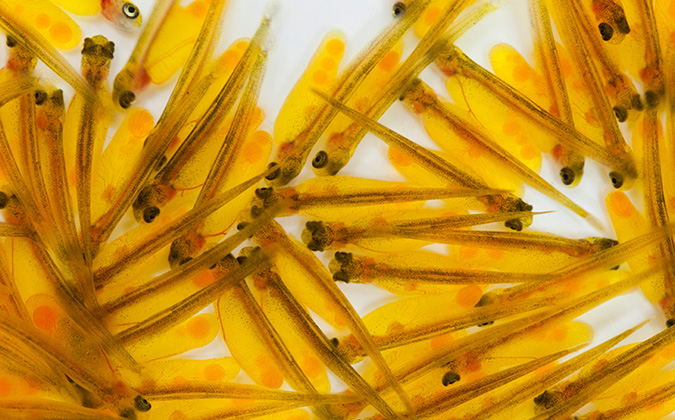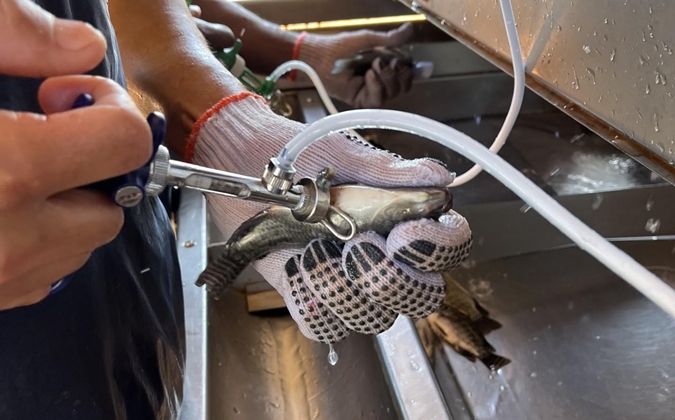
Fish Farm Forum is pleased to host this editorial page on behalf of Pharmaq.
Pharmaq
Artificial intelligence highlights which salmon eggs have the best chance of success
Software using artificial intelligence is set to help Atlantic salmon producers in Chile make better decisions about the chances of eggs developing successfully into healthy fish, reducing the productivity losses in early fish development which have significant effects on the aquaculture industry.
Changes in fish eggs and embryos can come about for several reasons, such as congenital causes or environmental or management factors. Of the well over 500 million eggs produced by the industry every year, 30% to 50% die at the embryonic stage,1 leading to losses in the tens of millions of dollars every year.
Early changes hit fish development
Asymmetric or incomplete divisions during the first stages of embryo development have been associated with the most common anomalies, which include incomplete development of the embryo’s eyes and other organs, curvature of the spine and muscle alterations. Problems that can occur in later developmental phases include alterations in the fins, circulatory system and musculoskeletal system, and swelling of the yolk sac.
Such problems can be aggravated by rearing conditions, and in Chile, the process is different from natural spawning, which occurs in late autumn or early winter. Chilean producers achieve spawning all year round by manipulating light and temperature. Although egg production improved from the early days of the country’s industry, where it was assumed that two eggs are required to produce one smolt, the infectious salmon anemia crisis which hit between 2007 and 2009 set things back again, explained Carlos Lobos, business unit director for PHARMAQ. After this point, embryo maturation became a pressing issue.
Bypassing bias of human observation
Until now, decisions about egg fertilization success and fish chances of survival have been based on examination with the naked eye. But now, supported by the Chilean Economic Development Agency (CORFO), a team from PHARMAQ Analytiq based in Puerto Montt has developed diagnostic software based on a new algorithm, which uses visual data to make predictions about the viability of eggs.
The AI software designed by the team was trained using expert visual analysis of eggs and embryos at different stages, which were graded and recorded, informing a specially designed algorithm. As a result, the software can categorize eggs as normal, unviable and altered. During the project, once the eggs had been categorized, the scientists followed their progress to see their performance over time and validate the algorithm’s predictions.
The software’s predictions on the successful fertilization of eggs ranged from 70% to 98%, while for embryo viability the figures ranged from 94% to 99%.
“The ability to generate more accurate and robust data and technological improvements have made it possible to make more detailed observations,” said Lobos, who led the work.
“Using our algorithms, we can automate and take measurements earlier and more precisely. This removes the bias of the observer and allows better interpretation of the viability of the embryos until the first feeding.”
Bringing new understanding
While the project served as a proof of concept, ultimately, the team hope to design a system where producers can enter their own images and receive a report generated by the AI. Using the time-saving predictions, they could then employ mitigation approaches such as altering environmental conditions or handling processes.
“What’s crucial is that producers can get these insights at a very early stage of fish development. It avoids a wait of maybe 2 weeks, when you can detect gross pathology and gross signs on the embryo,” Lobos explained.
Over the longer term, the information should allow the improved selection of broodstock based on those which have the greatest potential to produce healthy embryos, as well as identify environmental factors which consistently result in suboptimal viability and vitality of juvenile fish. On the latter, Lobos noted that some defects are strongly linked to temperature and oxygen levels in the water. “We are opening quite a big door and expect it will result in a lot of new findings,” he said.
Innovation prompts focus on healthy fish
The outcomes of the project represent a significant advancement in Chilean aquaculture, said Claudio Valenzuela, regional director of CORFO Los Lagos.
“By integrating artificial intelligence into the early detection of potential issues with salmon eggs and embryos, we are taking a proactive step towards improving productivity and sustainability,” he explained.
“This technology not only reduces economic losses by predicting the viability of fish at early developmental stages but also aligns with our broader goals of promoting innovative solutions that enhance environmental stewardship in aquaculture. The project underscores CORFO’s commitment to fostering technological innovation that addresses industry challenges and supports sustainable growth in our region.”
The work also marks what Lobos hopes will be a shift from dealing reactively with fish disease to providing insight into what makes a normal, healthy fish.
“When things are bad, there are too many effects at the same time, and it’s difficult to build the diagnostics. We are offering our customers tools to ensure that their fish are in good shape,” he added.
“This new software is part of this, allowing them to know when fish change from normality to disease. Using early observations, you can know when things are running well and when to make changes to avoid trouble down the line.”
1 SERNAPESCA. Salmon Health Report. 2023.
Posted on: October 07, 2024







